
Match Preview


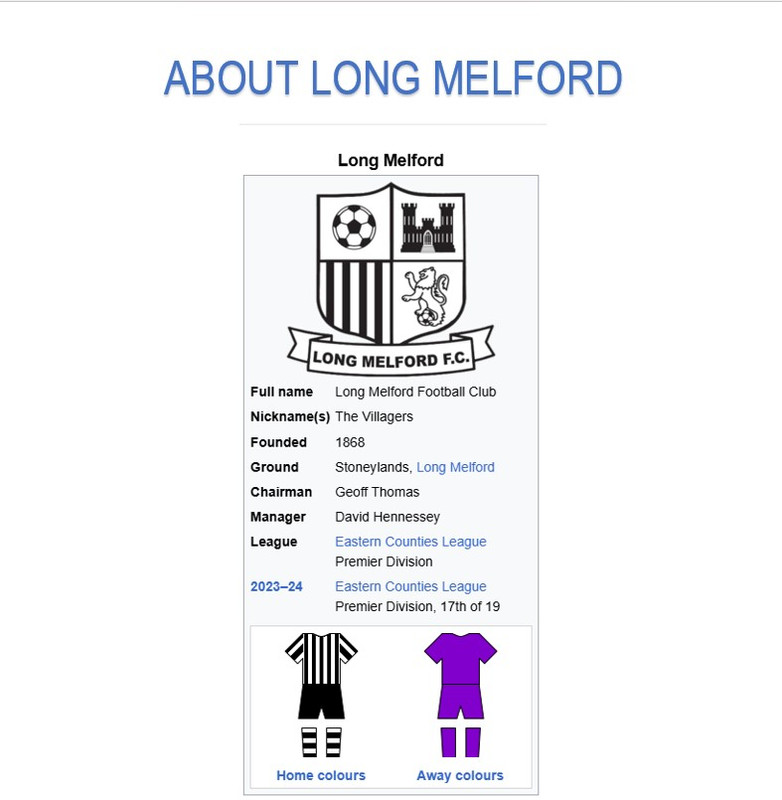
HISTORY
Long Melford Football Club is a football club based in Long Melford, Suffolk, England. Affiliated to the Suffolk County FA, they are currently members of the Eastern Counties League Premier Division and play at Stoneylands.
The existence of the club was first recorded in 1868, when they won a match against Ipswich Rangers 5–1 on the Church Green. William Cobbold played for the club in their early years, and was later capped by England. During the 1887–88 season Long Melford played fifteen games, winning all but two. Following their success, they challenged Ipswich Town to a match. Although Ipswich declined, claiming that it would be injurious to their prestige if they played "little village teams", the two clubs met in the Suffolk Senior Cup semi-final, with Long Melford winning 2–1 before going on to beat Woodbridge 1–0 in a replay in the final. The club won the Senior Cup again in 1894–95, beating Saxmundham 2–1, and for a third time in 1909, beating Bury Town 1–0 in a replay. This scoreline was repeated in the 1921 final between the two clubs. In 1934 the club joined Division One of the Ipswich & District League, but left after a single season.
The 1950s were one of Long Melford's most successful periods; they won the Senior Cup in 1952–53 and retained it the following season, also finishing as runners-up in the Essex and Suffolk Border League Premier Division. In 1954–55 they won the Senior Cup for a third successive season and were Premier Division champions. The following season saw them retain the Premier Division title, and they were champions for a third time in a row in 1956–57, also winning the league's Knock-Out Cup with a 9–3 aggregate win over Bury Town Reserves. After finishing as runners-up in 1957–58, the club won their fourth title in five seasons in 1958–59. A fifth Premier Division title was won in 1960–61 and they were runners-up in 1962–63, but the club subsequently went into decline and were relegated to Division One by the end of the decade.
The 1970–71 season saw Long Melford finish as runners-up in Division One. They won the division in 1984–85 and were Knock-Out Cup winners the following season. The club won the Knock-Out Cup again in 1989–90, and after finishing as runners-up in the Premier Division in 2001–02, they were promoted to Division One of the Eastern Counties League. The club's first season in the Eastern Counties League ended with them winning the Suffolk Senior Cup for the eighth time, beating Stanton 5–0. In 2014–15 they won the Division One title and were promoted to the Premier Division. The club won the League Cup in 2018–19, defeating Fakenham Town 1–0 in the final.
Ground
Long Melford’s home is Stoneylands, otherwise known as The Skyline Networks Stadium and is in New Road, Long Melford. Details below:
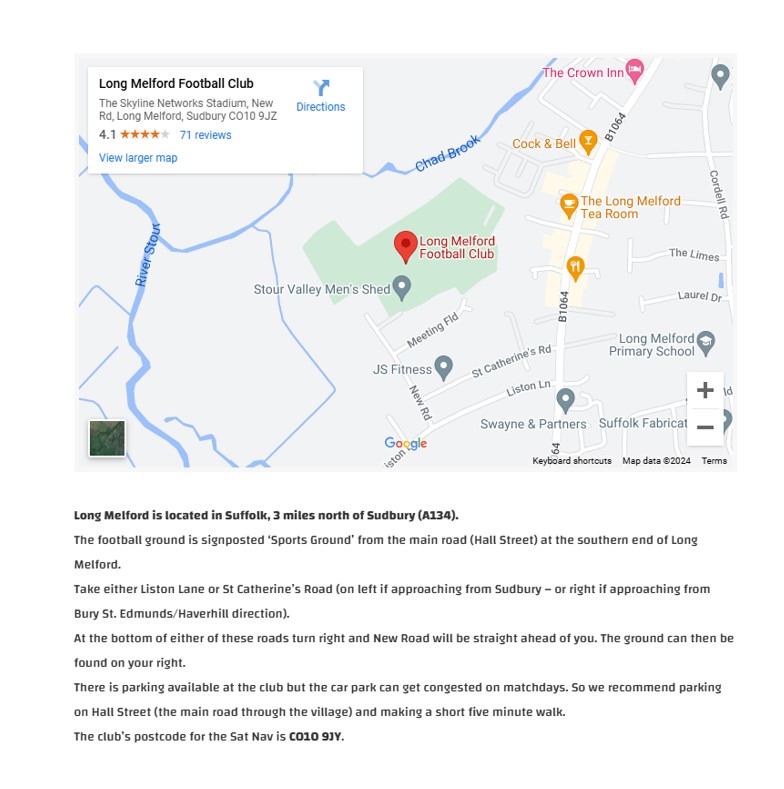
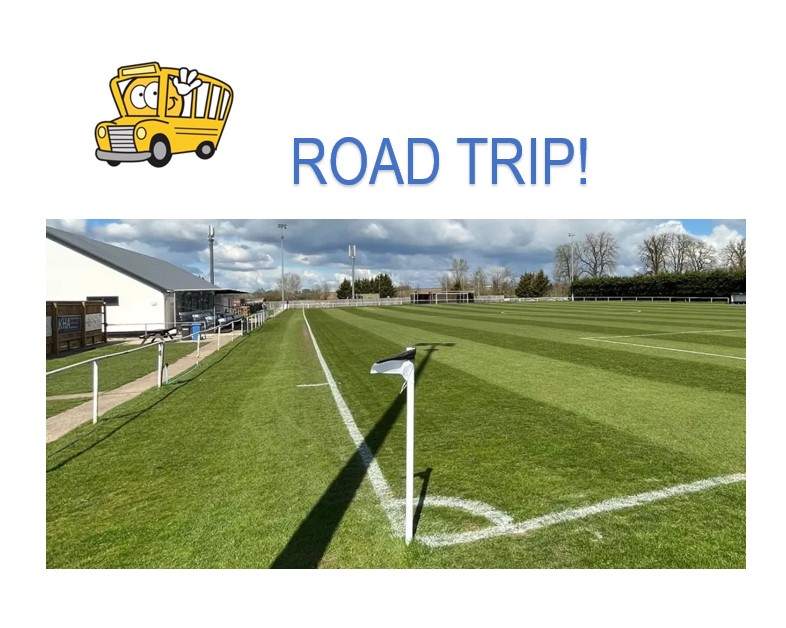
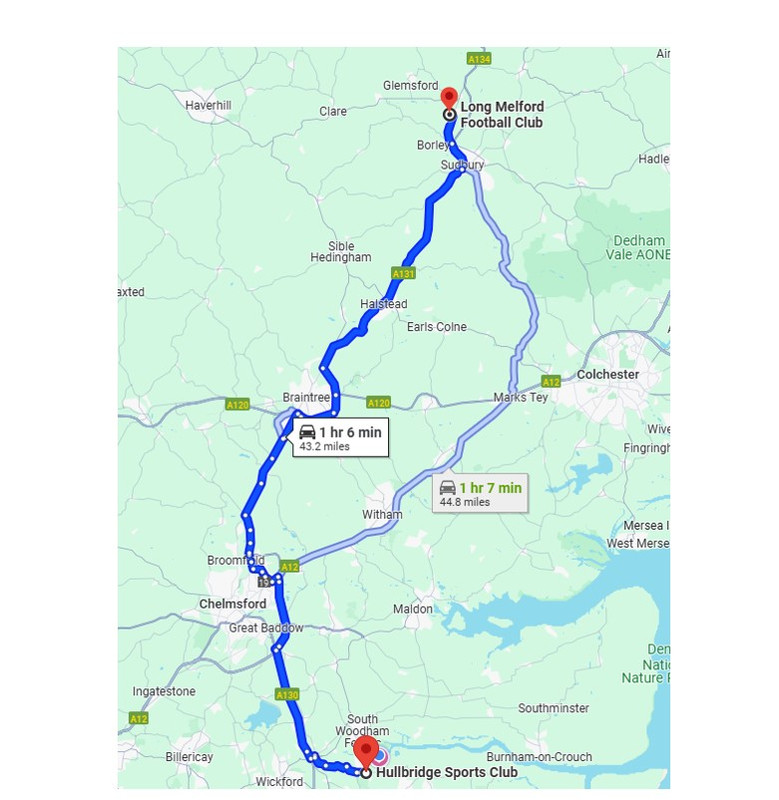
1 hour and 6 minutes (in current traffic conditions) up the A12 and A131 or a minute more and it’s A12 all the way!
43.2 miles for FA Vase First Qualifying Round action as The Bridge hit the road for FA Vase glory!
Honours
Eastern Counties League
Division One Champions 2014–15
League Cup Winners 2018–19
Essex & Suffolk Border League
Premier Division champions 1954–55, 1955–56, 1956–57, 1958–59, 1960–61
Division One champions 1984–85
Knock-Out Cup winners 1956–57, 1985–86, 1989–90
Suffolk Senior Cup
Winners 1887–88, 1894–95, 1908–09, 1920–21, 1952–53, 1953–54, 1954–55, 2002–03
Records
Best FA Cup performance: Second qualifying round, 2004–05
Best FA Vase performance: Third round, 2004–05

Geography
Long Melford, colloquially and historically also referred to as Melford, is a large village and civil parish in the Babergh district, in the county of Suffolk, England. It is on Suffolk's border with Essex, which is marked by the River Stour, 3 miles (4.8 km) from Sudbury, approximately 16 miles (26 km) from Colchester and 14 miles (23 km) from Bury St Edmunds. It is one of Suffolk's "wool towns" and is a former market town. The parish also includes the hamlets of Bridge Street and Cuckoo Tye. In 2011 the parish had a population of 3918.
Its name is derived from the nature of the village's layout (originally concentrated along a 3-mile stretch of a single road) and the Mill ford crossing the Chad Brook (a tributary of the River Stour).
History
Prehistoric finds discovered in 2011 have shown that early settlement of what is now known as Long Melford dates back to the Mesolithic period, up to 8300 BC. In addition, Iron Age finds were made in the same year, all within the largely central area of the current village.
The Romans constructed two Roman roads through Long Melford, the main one running from Chelmsford to Pakenham. Roman remains were discovered in a gravel pit in 1828, a site now occupied by the village's football club. In 1997, Roman finds were uncovered including complete skeletons (with one being in a stone coffin), part of the original Roman Road, and complete samian ware pottery in a villager's garden.
In June 2013, some archaeological evidence of a Saxon and Bronze Age settlement in the northern area of the village was discovered by Carenza Lewis and her team from Cambridge University during a student dig.
Middle Ages
The Manor of Melford was given to the Abbey of St Edmundsbury by Earl Alfric about 1050. The village is recorded in the Domesday Book of 1086, which lists the manor of Long Melford as having 41 villagers, including two freemen, nineteen smallholders, and sixteen slaves. There were eight plough teams of the lord of the manor and seventeen others. The manor had both meadow and woodland, two mills, and one church. The livestock was three cobs, thirty cattle, 140 pigs, and 300 sheep. The neighbouring Manor of Kentwell is also recorded.
During the Middle Ages, the village grew and gained a weekly market and an annual fair in 1235.
Long Melford survived the Black Death in 1348-9, and was a brief stop-off in the Peasants' Revolt in 1381. By the early 15th century, the manor of Kentwell belonged to the Clopton family. John Clopton was arrested in 1461 and charged with treason. He was spared execution, released and returned to Kentwell. There he organised and largely helped to pay for the rebuilding of the parish church, a notable example of a wool church. During this time the wealth of the parish was increasing, with most of the inhabitants being free men, renting their homes and lands. Guilds were founded, and weaving cloth became a key part of the village's economy. In the official inspector's returns for the year 1446, there were as many as 30 named weavers in Long Melford, who between them produced 264 finished "cloths".
Following the Dissolution of the Monasteries, Henry VIII granted the manor to Sir William Cordell.
Modern era
In 1604, an epidemic of the plague arrived in Melford and 119 people died between the months of May and September. During the English Civil War, a Puritan mob of over one thousand arrived in Melford pursuing Elizabeth Savage, Countess Rivers, a staunch Catholic and Royalist, from her property in St Osyth to her Suffolk estate at Melford Hall. The hall was sacked and plundered and the Countess fled to Bury St Edmunds, then to London where eventually she was imprisoned for debt and died a pauper.
By the end of the 17th century, cloth production had once again become important in the area as many new entrepreneurs started to produce a range of materials known as 'Bays and Says', similar to baize and serge. These were lighter, cheaper types of cloth than the traditional woollen broadcloths that had been made in the 15th and 16th centuries but, once again, many of the cloth merchants became extremely wealthy and for some years prosperity returned to Melford.
Soon after the beginning of the 19th century, a range of new industries such as horsehair weaving, an iron foundry, a flax works, and coconut matting production started in Melford. By 1851, there were three horsehair manufacturers in Melford employing over 200 men, women, and children. Prince Bertie, who later became King Edward VII, together with Princess Alexandra visited the village in November 1865, and large archways were constructed at key points in their honour to welcome them in, with the crowds. During the 1880s, a series of wage cuts in the coconut industry caused widespread anger and eventually resulted in strike action. Feelings ran high, culminating in a riot breaking out on polling day in December 1885, during which considerable damage was caused throughout the village. Troops were summoned from Bury St Edmunds to restore order; they arrived by train and marched from Melford station to read the Riot Act from the steps of the Police Station.
In World War I, hundreds of village men volunteered to serve their country. They joined many diverse army regiments, such as the Scots Guards, Prince of Wales Regiment, Royal Engineers, and the Suffolk Regiment, serving in Gallipoli, Ypres, the Somme, and numerous military campaigns. Other men fought in the Royal Navy and the newly formed Royal Flying Corps. The personal stories of these 1,100 men and how the war affected the village is found in Long Melford and the Great War – The Stories of a Thousand Lives by David Gevaux. In October 1920, the village war memorial was unveiled and is located at the entrance of the Holy Trinity Church.
During World War II, Long Melford was a location for American and Allied service personnel, who flew B24 and B17 aircraft from two large bomber stations, RAF Lavenham and RAF Sudbury, located nearby. Troops from, amongst others, the Berkshire and Black Watch Regiments, were billeted and garrisoned within the village. Injured airmen, troops from the D-Day landings, and prisoners of war were treated at the large nearby 136th Station Hospital, located between Long Melford and Acton. Band leader Glenn Miller and his orchestra briefly visited Long Melford and played to injured airmen, invited locals and hospital staff at the 136th hospital in 1944.
German prisoners of war were interned at a camp near the 136th Station Hospital, and Italian prisoners were located at a camp at the nearby village of Borley. USAF personnel from bases at Lakenheath, Mildenhall, and Wethersfield airbases often lived within Long Melford. By the end of the war, two B24 Liberators, one B17 Flying Fortress, and one RAF de Havilland Mosquito had crashed in the parish with over twenty persons killed or injured. Numerous pillboxes and temporary gun emplacements were constructed in the village during the war, and in 2012 a previously unknown underground bunker room was located. According to the Remembrance Plaque at Holy Trinity Church, ninety-six serving villagers were killed in World War One, and eleven during World War Two.

17/08/24 Thurlow Nunn - Premier
LONG MELFORD 0
THETFORD TOWN 6
13/08/24 Thurlow Nunn - Premier
WALSHAM LE WILLOWS 3
LONG MELFORD 0
10/08/24 Thurlow Nunn - Premier
LAKENHEATH 2
LONG MELFORD 2
(George Frodsham, Ryan Gibbs)
03/08/24 FA Cup – Extra Preliminary Round
LONG MELFORD 1
(Freddie Pheby)
DOWNHAM TOWN 4
30/07/24 Thurlow Nunn - Premier
LONG MELFORD 0
BRANTHAM ATHLETIC 2
27/07/24 Thurlow Nunn - Premier
GREAT YARMOUTH TOWN 2
LONG MELFORD 0
“The Villagers” finished in 15th place in the English Counties Football League, known as the Thurlow Nunn League, in 2023/24 with 30 points from 36 matches. Their record was won 7, drawn 9, and lost 20. They scored 32 goals and conceded 70 for a -38 goal difference. They have continued this difficult trend into 24/25 and are currently 18th (third from bottom) with 1 point from 5 games (1 draw and 4 defeats). GD is -13, 2 goals scored and 15 conceded.
As you can see from the results above, they are in a poor run of form with 5 defeats in 6, including an exit from the FA Cup at the Extra Preliminary Round Stage.
Members of The Eastern Counties Football League, Long Melford play at the same level as The Bridge (Level 9).

Note – Source: FA Full-time Website
Kelly Ayiteyfio
Gabriel Bailey
Freddie Bayliss
Gregory Birch
Oliver Bloomfield
Mckenzie Bone
Max Boulter
Theo Boxall
Lee Branson
Jacob Brown
Thomas Chance
Benjamin Charway Jnr
Reuben Chinnery
Munashe Chirimuuta
Charlie Coy
James Dormady
Robert Dormady
Kai Dunning
Samuel Evans
Fraser Foy
George Frodsham
Jordan Gibbs
Ryan Gibbs
Joel greenwood
Lee Greenwood
Dean Harvey
Hugo Hertz
Ben Humphreys
Jake Jackson
Bailey Jacobs
Benjamin Judge
Oliver Judge
Carlos Lazar
Aaron Lee Cooper
Jacob Lodge
Perry Newman
Ethan Nyatanga
Ryan O'Byrne
Freddie Pheby
Kyran Quelch
Kieron Reddin
Cyrus Reed
Oliver Rodwell
Deklyn Roy
Connor Seymour
Dan Smith
William Thorp
Caden Vine
Matthew Walker
Harry Whiting-Noakes
Tyrese Williams

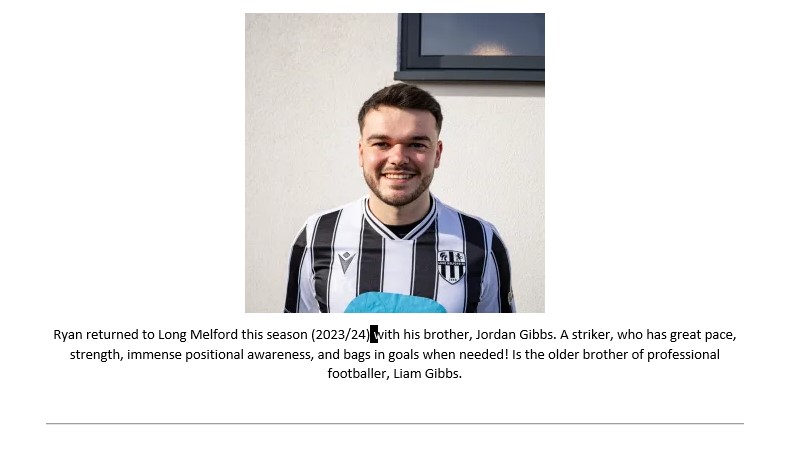

As Romford and Great Wakering Rovers proved last season, Essex Senior League teams can reach the final of the Vase. The Bridge will have to do better than previous records illustrate though…and so will Long Melford!
The furthest that The Bridge have gone since 1994-95 is Round 4. This happened on four occasions. In 2013-14 we were knocked out 3-1 by Sholing after beating Long Melford 4-0 in the 2nd qualifying round. In 2014-15 Flackwell Heath beat us 3-0 in Round 4 and in 2015-16 Berkhamsted Town beat us 4-2 in that Round. The most recent round 4 knockout was in 2017-18, losing 5- 1 to Tring Athletic.
As for Long Melford, I've only got their records since 2003-04 but they have never done that well, the furthest they have achieved was back in 2004-05 when they went out in a round 3 replay 3-0 to Brook House. Last season they went out 3-0 to Saffron Walden Town in round 1, the same team that knocked The Bridge out 2-0 in round 2.












